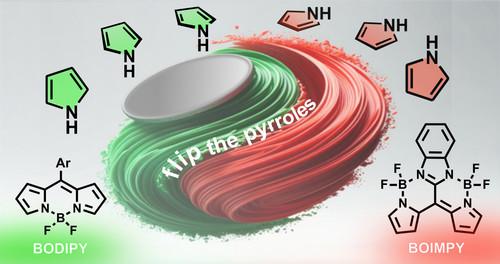Rational Design of Fluorophores Using MO Theory: Our Journey from BODIPYs to BOIMPYs
引用次数: 0
Abstract
This short review demonstrates how MO-theoretical considerations can support the tailor-made design of new dye scaffolds, specifically the recently introduced BOIMPY class of fluorophores. Starting with historical and structural foundations, the influence of canonical streptocyanines on the electronic features of diarylmethanes and rhodamines is examined and the BODIPY scaffold is introduced as the primary structural inspiration for our work. The attachment of five-membered ring heterocycles at the meso position of the BODIPY core enables a relaxation into a co-planar and twofold chelating triarylmethane system. After introduction of two electron-withdrawing BF2 units efficient rigidity is achieved since hindered rotation prevents non-radiative dissipation of energy via vibrational relaxation. Hence, a lowered LUMO level allows the combination of a large red shift with high quantum efficiencies. The synthetic approach to these systems is straightforward and analogous to BODIPY syntheses starting from benzimidazole or tetrazole carbaldehydes. Cyclic voltammetric measurements prove that BOIMPYs are able to easily accept two electrons and might act as efficient photoredox catalysts.

利用 MO 理论合理设计荧光团:我们从 BODIPY 到 BOIMPY 的历程
这篇简短的综述展示了 MO 理论如何支持新染料支架的定制设计,特别是最近推出的 BOIMPY 类荧光团。文章从历史和结构基础入手,探讨了典型链花青素对二芳基甲烷和罗丹明电子特性的影响,并介绍了 BODIPY 支架作为我们工作的主要结构灵感来源。在 BODIPY 核心的中位连接五元环杂环,可放松成共平面和双重螯合的三芳基甲烷体系。在引入两个抽电子 BF2 单元后,由于受阻旋转防止了能量通过振动弛豫的非辐射耗散,因此实现了有效的刚性。因此,较低的 LUMO 水平可以将较大的红移与较高的量子效率结合起来。这些系统的合成方法简单明了,类似于从苯并咪唑或四唑羧醛开始的 BODIPY 合成。循环伏安测量证明,BOIMPYs 能够轻松接受两个电子,可以作为高效的光氧化催化剂。
本文章由计算机程序翻译,如有差异,请以英文原文为准。
求助全文
约1分钟内获得全文
求助全文

 求助内容:
求助内容: 应助结果提醒方式:
应助结果提醒方式:


